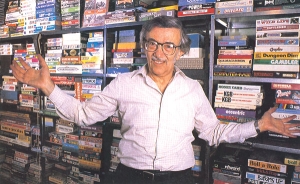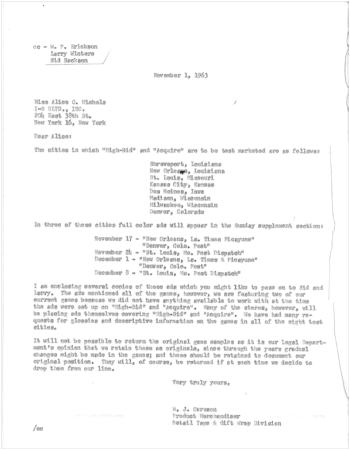One of the last issues in the contract was to address possible competition or “knock-offs” of the game. 3M wanted an automatic suspension of royalty payments to the inventor if they had to enter litigation against a knock-off game. I/S Unlimited argued that the royalty payment should be reduced by the amount of the cost of litigation. Either way, Sid or his heirs would be responsible to pay for litigation and it would not be the responsibility of the game company to protect the game against competition.
It only took 19 days and Sid was writing in his diary on October 9, 1963 that he “Went to I/S Ultd. Inc. about ACQUIRE contract.” Two days later he writes, “Signed contract for ACQUIRE (Vacation).” It appears that he was still trying to adjust to the name change since it had only been proposed a month prior. Since this was Sid’s first major contract for one of his game ideas, the last month was most likely a huge whirlwind for him. 3M had latched onto his idea, incorporated it into another idea they had been developing, and were poised to get it on the market rapidly.
3M was obviously sending him many updates of their progress. The game was progressing rapidly and was heading for market in just a couple of months. On October 21, 1963, just ten days after signing the contract, Sid wrote a letter to Bill Caruson. The main objective that he had with all the whirlwind of changes that were happening with his game was that he thought 3M shouldn’t market it as a “Stock Market” game. He wrote in the letter:
“Acquire is, of course, much more than merely a matter of buying and selling stock. I think it would be desirable to de-emphasize the stock market angle and instead get across the idea that in Acquire players really have the elbow room to wheel and deal and plan, not being limited by chance devices such as dice, cards, or spinners.”
Eleven days later on November 1, 1963, Bill Caruson of 3M wrote a letter to Alice Nichols at I/S Ultd telling them the cities in which the first games of ACQUIRE will be test marketed. The eight cities that were chosen were all in Mid-America. They were Shreveport and New Orleans, Louisiana, Madison and Milwaukee, Wisconsin, Des Moines, Iowa, Kansas City, Kansas, St. Louis, Missouri, and Denver, Colorado. The choice of these cities was probably in relation to the location of the 3M Corp in Minneapolis, Minnesota.
In the same letter, Mr. Caruson addressed a request for return of the “original game samples.” Obviously Sid had asked to have his original work, which he had given to 3M to jump start the game, returned to him. Mr. Caruson wrote:
“It will not be possible to return the original game samples as it is our Legal Department’s opinion that we retain these as originals, since through the years gradual changes might be made in these games; and these should be retained to document our original position. They will, of course, be returned if at such time we decide to drop them from our line.”
Mr. Caruson also wrote a letter to Sid on the same day stating, “We should have finished games sometime next week, and I will get one in your hands just as soon as possible.”
Three days later, on the 14th of November 1963, Sid wrote in his diary that he received artwork and instructions. By November 27th, Mr. Caruson was writing a letter stating that they had the games completed and they would send one to Sid. Caruson complained about the artwork on the money and said it could be corrected on future production runs. There was also some problem with the box sleeve that made it crooked. 3M was rushing to get this corrected so the ones that hit the stores did not look as bad.
By November 30th, Caruson tells Sid that his copy is on the way. Sid’s agent, Alice, received her copy by December 2nd. Sid didn’t get his until the 10th. He wrote a letter to Caruson on the 13th stating that he was a little upset with the Post Office.
Sid was very impressed with this first game. He also outlined mistakes that he had noticed and changes he would like to see made. One of the changes Sid suggested was:
“One pointer I would like to see in the tips is to keep on the alert for the opportunity to pick up a “second bonus” cheaply. Very often players will get into “ruinous” battles for “first” in one chain while neglecting the chance for “second” in other chains from just the purchase of one or two stocks.”
This advice never did make it into the rule booklet, but it still remains solid advice today.
In a December 21, 1963 diary entry Sid writes, “Played ACQUIRE with Dad & Dana.” Sid was first notified on April 24, 1963 that 3M was interested in his game called “VACATION.” Now just 8 months later, he is playing his game. His original idea has been modified slightly, and the name was changed, but it was his game, produced by a major manufacturer. On December 31st, at the end of that year, 3M had already sold $1,029.80 in games (approximately 148 games). Sid’s 5% royalty netted him $51.49 (approximately 7 games). The game of ACQUIRE had come to life.





